
How to Noindex Low-Value Content in WordPress in 2 Simple Steps
Choose Your Language:
WordPress, a versatile platform for content creation, occasionally accumulates low-value content, which may dilute your site’s overall relevance and quality in the eyes of search engines.
Rather than deleting these contents entirely, a more practical approach is implementing a `noindex` directive. This technique instructs search engine bots to exclude those specific pages or posts from their index, improving your site’s SEO performance.
With or without plugins, using either your WordPress dashboard or your `robots.txt` file, you can effortlessly set up this feature. In this informative guide, we will walk you through the step-by-step process of how to `noindex` low-value content on your WordPress site.
Previously, How to Optimize Images for SEO In WordPress in 2023 (Only Guide You Need!)
1 Importance of SEO for a WordPress site
Search Engine Optimization (SEO) is critical for any WordPress site aiming for visibility and higher rankings on search engines like Google. When implemented correctly, SEO practices help search engine bots better understand your site content, leading to more accurate indexing and higher site rankings in search results.
This drives organic traffic to your site, boosts user engagement, and ultimately increases conversions and returns on investment.
Maintaining optimal SEO practices, including managing low-value content, is paramount for a WordPress site, where content is frequently updated and added. This ensures that all content contributes positively to the site’s search engine performance rather than diluting the overall relevance and quality.
2 Introduction to `noindex` and its Role in SEO
The `noindex` directive is vital in shaping your website’s SEO strategy. It’s a specific command you can use to instruct search engine bots not to include certain web pages in their index.
This means that the pages marked with `noindex` won’t appear in search engine results pages (SERPs), preventing them from potentially diluting the value of your site’s more relevant, high-quality content.
This feature becomes particularly useful when dealing with low-value content on your WordPress site. While such pages might be necessary for your site’s functionality or user experience, they may not provide significant value in the context of search rankings.
Applying the `noindex` directive to these pages ensures that search engines focus on indexing and ranking your high-value content, optimizing your overall SEO performance.
3 Understanding Low-Value Content in WordPress
Low-value content refers to pages or posts on your WordPress site that don’t provide substantial value for your website’s SEO performance.
They might include archive pages, tag pages, author pages, or thin content pages with limited original content. While these pages may serve specific functions or enhance user experience, they don’t necessarily contribute to your site’s search engine rankings.
They can dilute your SEO efforts, as search engine bots crawl and index these pages along with your high-value content. By marking such pages with the `noindex` directive, you can ensure that search engines prioritize your most relevant and meaningful content, optimizing your website’s organic search performance.
4 Identifying Common Low-Value Content Pages in WordPress
While the definition of low-value content can vary depending on your website’s specific goals and context distract search engine attention, some common types of pages on WordPress typically don’t contribute significantly to SEO performance and may therefore be considered for the `noindex` directive. These include:
- Archive Pages: These are automatically generated pages that aggregate your older posts based on specific criteria like date, category, or tag. While useful for navigation, these pages often contain duplicate content and thus may not hold much SEO value.
- Tag Pages: Like archive pages, tag pages group related posts together based on assigned tags. However, given that the content on these pages is usually duplicated elsewhere on your site, they may not add much value from an SEO perspective.
- Author Pages: If your WordPress site has a single author, the author page(s) may simply replicate content found on other pages, thus offering little unique value for SEO.
- Thin Content Pages: These are pages with little or no original content, such as “Thank You” or login pages. While they serve important functions, these pages do not typically contribute to your site’s search engine rankings.
- Attachment Pages: WordPress generates a separate webpage for each media file you upload (images, videos, PDFs, etc.). These pages often contain minimal content and may distract search engine attention from your more valuable pages.
Remember, not all low-value content should be tagged with `noindex`. It’s important to evaluate each page’s purpose, content, and contribution to user experience before making this decision.
5 How to Find Content That Gets Traffic or No Clicks (Using RANKMATH)
To evaluate the performance of your content and identify pages that are getting traffic or no clicks, you can utilize the SEO tool RANKMATH. This tool provides detailed analytics that helps you understand which pages of your site contribute to your SEO and which aren’t. Here’s how you can use RANKMATH to identify content with zero clicks or traffic:
On your WordPress dashboard, locate and click the ‘RANKMATH’ option on the left sidebar. This will open a dropdown menu.From the dropdown menu, select ‘Analytics’. This will redirect you to the ‘Analytics’ page.
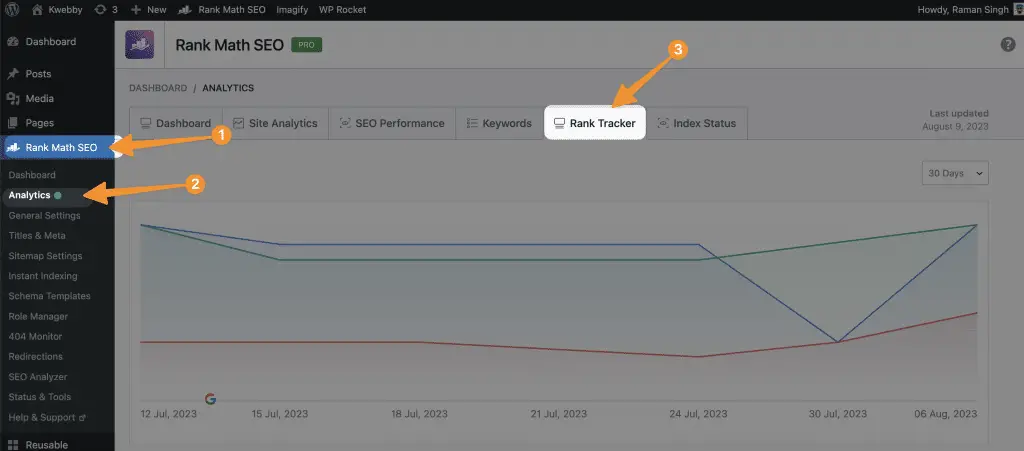
Find and click the ‘ Rank Tracker ‘ on the ‘Analytics’ page. This tab will provide vital information about your site’s Google search rankings. Inside the ‘Rank Tracker’, you’ll see a ‘Clicks’ menu. Click on this menu to reveal a list of your website’s URLs.

Now you need to click on any of the keywords you found with zero traffic, just click on it and a new dropdown data will open as below;
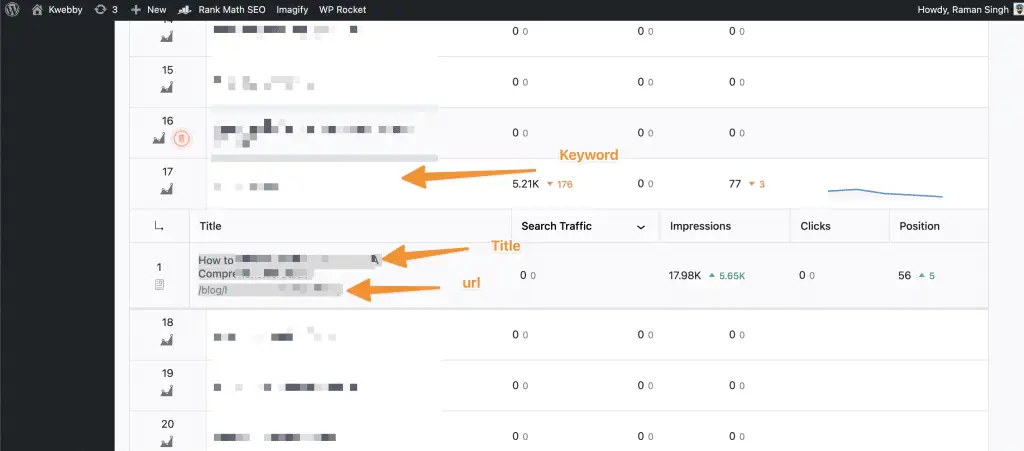
Here, you will find your blog link, blog title and keyword for which you’re not getting any traffic, therefore, for this, you need to either update the content or redirect to the best related post which we have described below.
Within this list, you can select and analyze the URLs that have zero clicks or traffic. These pages on your site are not contributing to your SEO, and could be considered for the `noindex` directive.
Use this process regularly to keep track of your site’s performance and to ensure that your high-value content is getting the attention it deserves, while your low-value content is appropriately managed.
6 How to Noindex Low-Value Content in WordPress (Without Plugin)
The process to `noindex` low-value content on your WordPress site without using a plugin is relatively straightforward. This method involves editing your site’s `robots.txt` file.
You will find your robots.txt file in your root domain as below;
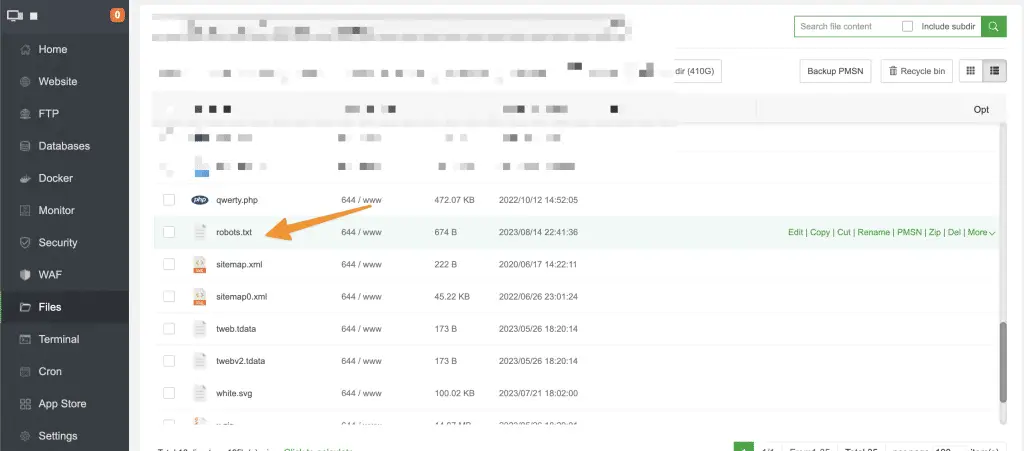
If you couldn’t find your file above, then you need to create new file with name robots.txt
If you only want to `noindex` specific low-value pages, tags, categories, or posts, you’ll need to manually add the `noindex` directive to your `robots.txt` file or to the HTML of each page you want to exclude. This method requires some understanding of website code, so proceed with caution.
To add `noindex` to your `robots.txt` file, you must access your website’s root directory and locate the file. Open it and add the following lines:
User-agent: *
Noindex: /category/
Noindex: /tag/
Noindex: /author/
Noindex: /attachment/Alternatively you can disallow search engine crawler to not to crawl these directories, therefore, for this, updated robots.txt code is
User-agent: *
Disallow: /category/
Disallow: /tag/
Disallow: /author/
Disallow: /attachment/This will prevent search engines from crawling these pages and thus, keeping them out of the search engine results.
This will prevent all search engines from indexing your category and tag pages. You can also replace “/category/” and “/tag/” with the slug of any other page or post you want to `noindex`.
Remember, modifying the `robots.txt` file affects how search engines interact with your site, so use this authority wisely. Always double-check your entries before saving, and consider consulting with a professional if you’re unsure.
7 How to Noindex Low-Value Content in WordPress (With Plugin)
If you prefer a more user-friendly approach, you can use a WordPress SEO plugin to `noindex` low-value content. RANKMATH SEO is one of the most popular plugins that offers this feature. Here’s how you can use it:
7.1 Noindex Categories Pages/Archives
To Noindex categories pages, you need to go to RANKMATH > Title & Metas;
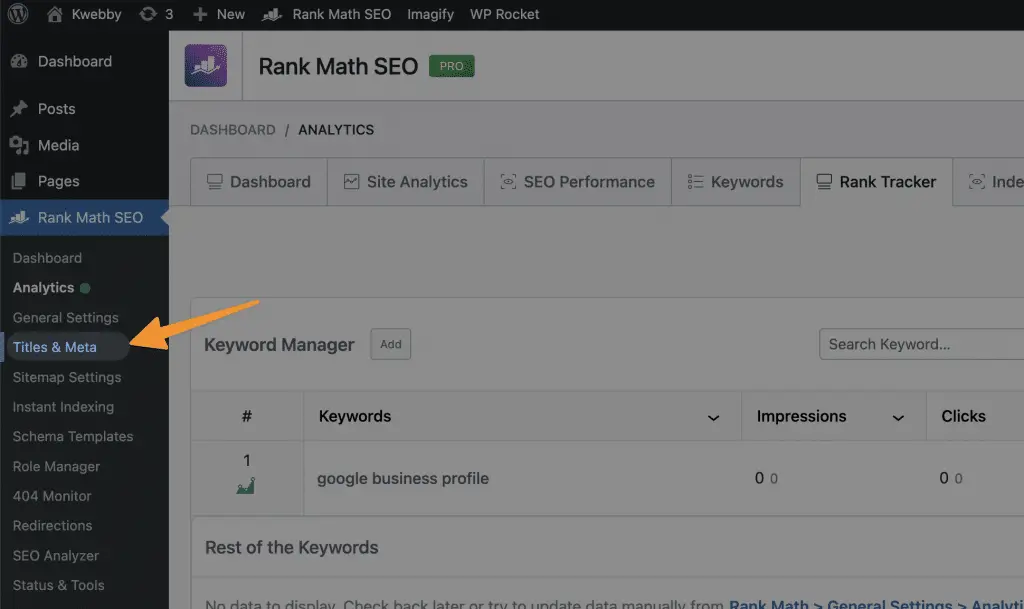
Then, click on the Categories section as below;
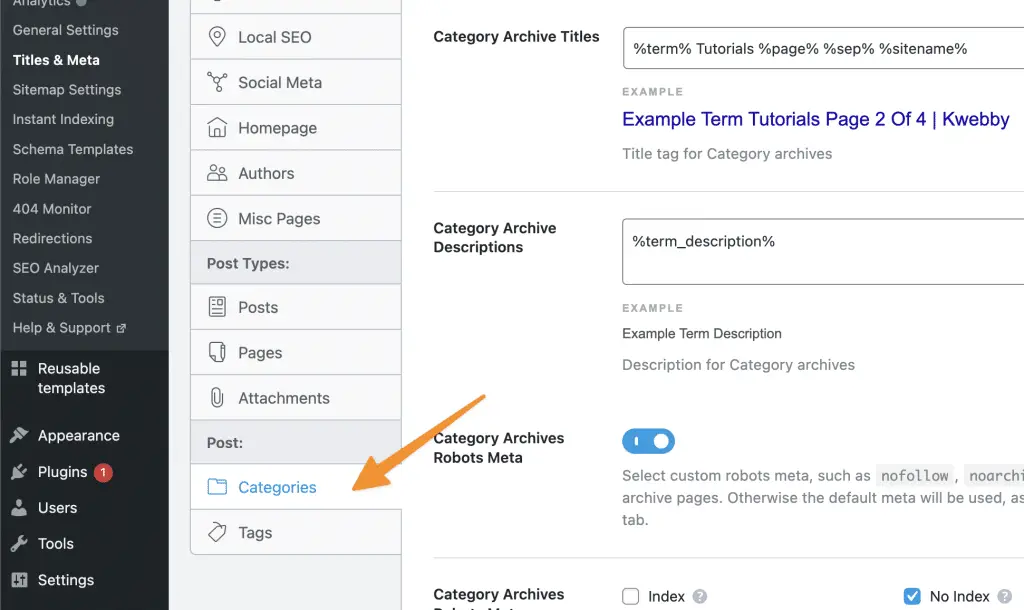
Now, you need to select ‘Noindex” from Category Archives Robots Meta;
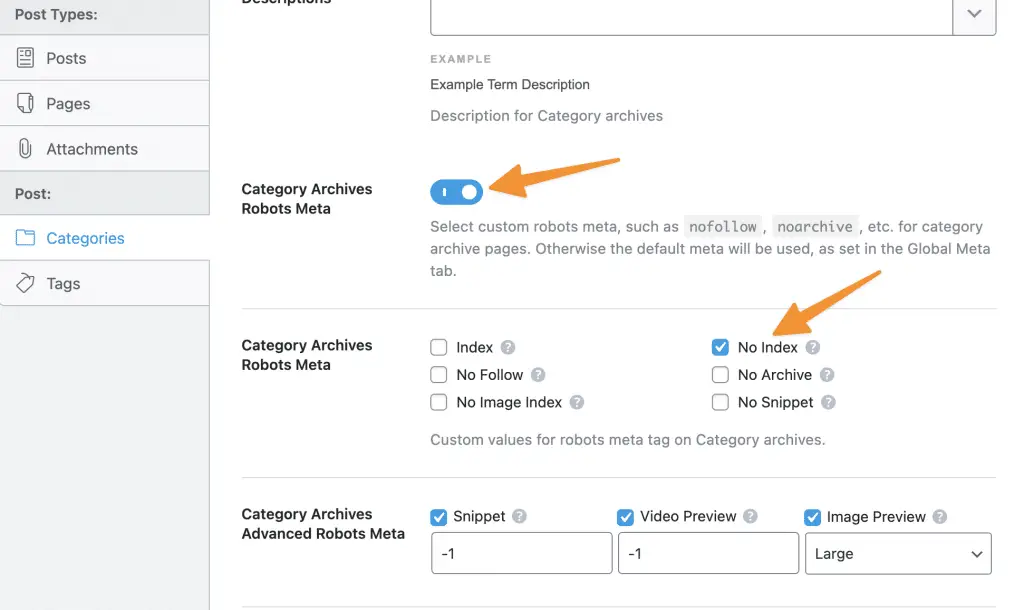
And then click on “Save Changes”.
7.2 NoIndex Tag Pages/Archives
To Noindex Tag pages, the process is the same as above; from the same page as on above, select the tags tab from the left and then, scroll down and then you need to select ‘Noindex” from Category Archives Robots Meta;
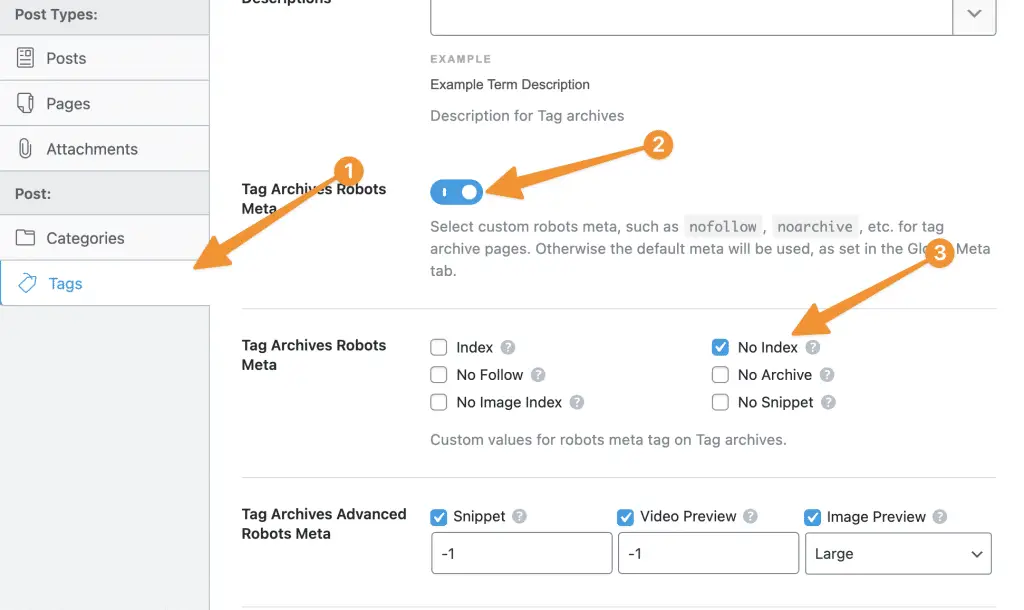
and then click on “Save Changes.”
7.3 NoIndex Author Page
To the Noindex Author page, you can use the same process above by selecting “Author” from the left side menu and then, scroll down, and you need to select ‘Noindex” from Category Archives Robots Meta;

and then click on “Save Changes”.
7.4 NoIndex Attachment Pages/Archives
For Noindex Attachment pages, the process is the same as above. From RANKMATH > Title & Metas, select the ‘Media’ tab from the left side and then scroll down, and you need to select ‘Noindex” from Media Archives Robots Meta;

and then Click on “Save Changes”.
7.5 Redirect Non-Performing Blog Posts to Relevant Using RANKMATH’s Redirection Module
If you’re trying to optimize the content on your website, redirecting non-performing blog posts to relevant pages is a great way to improve the user experience while optimizing SEO performance.
RANKMATH’s Redirection module makes managing redirects from your WordPress dashboard easy. First, you need to go to RANKMATH > Redirections > Add New as below;
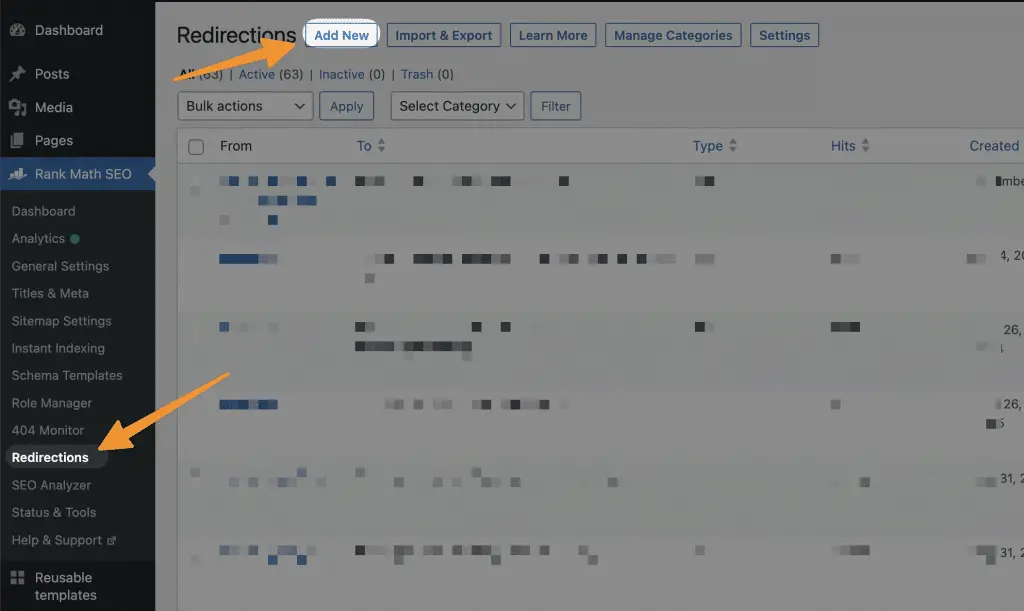
You must select the source and target URLs for the post or page you want to redirect (301 redirections) and click save.

Using this tool, you can set up 301 redirects for low-value content pages not delivering the expected performance. This will help search engines associate higher-value content with relevant keywords while improving your overall user experience.
No indexing low-value content in WordPress is an essential part of any SEO strategy. Whether you use the `robots.txt` file or a plugin like RANKMATH, this process helps search engines focus on high-quality content while keeping your website up to date.
Review and double-check your changes often—incorrectly configured `noindex` tags can significantly hurt your SEO performance.
More from WordPress SEO;
- How To Mark Up Your Posts/Pages With Schema In WordPress To Skyrocket SEO (2 Easy Way)
- How To Enable Seo-Friendly Permalinks In WordPress in 2023
- How To Show ‘Last Updated’ Dates In WordPress (3 Easy Methods)
8 Frequently Asked Questions
You will find a curated list of FAQs below to summarise the content you have learned.
9 Q1. What does `noindex` mean in SEO?
`Noindex` is a directive you can add to your website’s code or `robots.txt` file. It tells search engines not to include the page in their search results, making it invisible to SEO. This is particularly useful when dealing with low-value or duplicate content that might negatively impact your site’s SEO performance.
10 Q2. How do I identify low-value content on my WordPress site?
Low-value content typically refers to pages or posts on your website that aren’t contributing towards your SEO performance. They can include pages with zero traffic or clicks. You can identify these pages in your WordPress site’s ‘Rank Tracker’ under the ‘Clicks’ menu.
11 Q3. Can I `noindex` content in WordPress without using a plugin?
Yes, you can `noindex` content directly in WordPress by editing your website’s `robots.txt` file and adding the `noindex` directive to the HTML of each page you want to exclude. However, this requires some understanding of website code and should be done with caution.
12 Q4. Is there an easier way to `noindex` content in WordPress?
Yes, several SEO plugins for WordPress make it easy to `noindex` low-value content, such as RANKMATH SEO. These plugins provide a user-friendly interface where you can select which pages or posts to `noindex`.
13 Q5. If I `noindex` a page, will it disappear from search engines immediately?
After you’ve added the `noindex` directive to a page, it won’t disappear from search results immediately. It will only disappear after search engines have recrawled your site and registered the change. This can take anywhere from a few days to a few weeks.
14 Q6. Can incorrectly configured `noindex` tags hurt my SEO performance?
Yes, if `noindex` tags are incorrectly configured, they can significantly hurt your SEO performance. It’s essential to double-check your changes and consult with a professional if you’re unsure.
15 Final Thoughts
By noindexing low-value content, you can strengthen the overall SEO performance of your WordPress site. This helps search engines focus on indexing and ranking your most important content, thus optimizing your website’s organic traffic.




